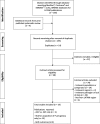Pseudomonas infections among hospitalized adults in Latin America: a systematic review and meta-analysis
- PMID: 32220233
- PMCID: PMC7099820
- DOI: 10.1186/s12879-020-04973-0
Pseudomonas infections among hospitalized adults in Latin America: a systematic review and meta-analysis
Abstract
Background: Treatment of resistant Pseudomonas aeruginosa infection continues to be a challenge in Latin American countries (LATAM). We synthesize the literature on the use of appropriate initial antibiotic therapy (AIAT) and inappropriate initial antibiotic therapy (IIAT) in P. aeruginosa infections, and the literature on risk factors for acquisition of resistant P. aeruginosa among hospitalized adult patients in LATAM.
Methods: MEDLINE, EMBASE, Cochrane, and LILAC were searched between 2000 and August 2019. Abstracts and full-text articles were screened in duplicate. Random effects meta-analysis was conducted when studies were sufficiently similar.
Results: The screening of 165 citations identified through literature search yielded 98 full-text articles that were retrieved and assessed for eligibility, and 19 articles conducted in Brazil (14 articles), Colombia (4 articles), and Cuba (1 article) met the inclusion criteria. Of 19 eligible articles, six articles (840 subjects) examined AIAT compared to IIAT in P. aeruginosa infections; 17 articles (3203 total subjects) examined risk factors for acquisition of resistant P. aeruginosa; and four articles evaluated both. Four of 19 articles were rated low risk of bias and the remaining were deemed unclear or high risk of bias. In meta-analysis, AIAT was associated with lower mortality for P. aeruginosa infections (unadjusted summary OR 0.48, 95% CI 0.28-0.81; I2 = 59%), compared to IIAT and the association with mortality persisted in subgroup meta-analysis by low risk of bias (3 articles; unadjusted summary OR 0.46, 95% CI 0.28-0.81; I2 = 0%). No meta-analysis was performed for studies evaluating risk factors for acquisition of resistant P. aeruginosa as they were not sufficiently similar. Significant risk factors for acquisition of resistant P. aeruginosa included: prior use of antibiotics (11 articles), stay in the intensive care unit (ICU) (3 articles), and comorbidity score (3 articles). Outcomes were graded to be of low strength of evidence owing to unclear or high risk of bias and imprecise estimates.
Conclusion: Our study highlights the association of AIAT with lower mortality and prior use of antibiotics significantly predicts acquiring resistant P. aeruginosa infections. This review reinforces the need for rigorous and structured antimicrobial stewardship programs in the LATAM region.
Keywords: Antibiotic therapy; Appropriate; Inappropriate; Latin America; Pseudomonas aeruginosa; Resistance; Risk factors.
Conflict of interest statement
S. Merchant, G. T. Hernandez, and E. Sarpong are employees of Merck Sharp & Dohme Corp., a subsidiary of Merck & Co., Inc., Kenilworth, NJ, USA.
Figures


References
-
- Antibiotic resistance threats in the United States, 2013. Atlanta, Center for Disease Control. http://www cdc gov/drugresistance/threat-report-2013/pdf/ar-threats-2013-508 pdf 2013;Available from: URL: http://www.cdc.gov/drugresistance/threat-report-2013/pdf/ar-threats-2013... [cited 2017 May 15]..
-
- Antimicrobial Resistance Global report on surveillance. Geneva, World Health Organization. http://apps who int/iris/bitstream/10665/112642/1/9789241564748_eng pdf 2014;Available from: URL: http://apps.who.int/iris/bitstream/10665/112642/1/9789241564748_eng.pdf [cited 2017 May 15]..
-
- Farrell DJ, Sader HS, Flamm RK, Jones RN. Frequency of occurrence and antimicrobial susceptibility of Gram-negative organisms isolated from health care–associated (HCA) urinary tract infections (UTI) in the United States: Results from the Program to Assess Ceftolozane/Tazobactam Susceptibility (PACTS). Open Forum Infect Dis. 2014;1(suppl_1):S105–6.
-
- Sader HS, Farrell DJ, Flamm RK, Jones RN. Ceftolozane/tazobactam activity tested against aerobic gram-negative organisms isolated from intra-abdominal and urinary tract infections in European and United States hospitals (2012) J Inf Secur. 2014;69(3):266–277. - PubMed
Publication types
MeSH terms
Substances
Grants and funding
LinkOut - more resources
Full Text Sources
Medical
Miscellaneous

